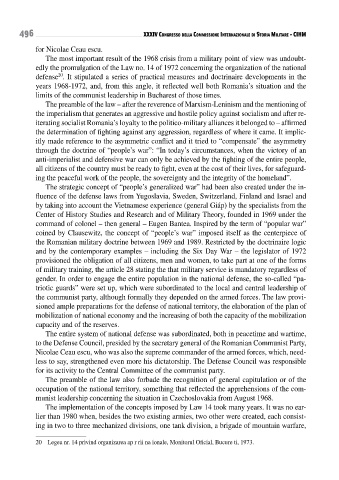Page 496 - Conflitti Militari e Popolazioni Civili - Tomo I
P. 496
496 XXXIV Congresso della CommIssIone InternazIonale dI storIa mIlItare • CIHm
for Nicolae Ceaučescu.
The most important result of the 1968 crisis from a military point of view was undoubt-
edly the promulgation of the Law no. 14 of 1972 concerning the organization of the national
20
defense . It stipulated a series of practical measures and doctrinaire developments in the
years 1968-1972, and, from this angle, it reflected well both Romania’s situation and the
limits of the communist leadership in Bucharest of those times.
The preamble of the law – after the reverence of Marxism-Leninism and the mentioning of
the imperialism that generates an aggressive and hostile policy against socialism and after re-
iterating socialist Romania’s loyalty to the politico-military alliances it belonged to – affirmed
the determination of fighting against any aggression, regardless of where it came. It implic-
itly made reference to the asymmetric conflict and it tried to “compensate” the asymmetry
through the doctrine of “people’s war”: “In today’s circumstances, when the victory of an
anti-imperialist and defensive war can only be achieved by the fighting of the entire people,
all citizens of the country must be ready to fight, even at the cost of their lives, for safeguard-
ing the peaceful work of the people, the sovereignty and the integrity of the homeland”.
The strategic concept of “people’s generalized war” had been also created under the in-
fluence of the defense laws from Yugoslavia, Sweden, Switzerland, Finland and Israel and
by taking into account the Vietnamese experience (general Giáp) by the specialists from the
Center of History Studies and Research and of Military Theory, founded in 1969 under the
command of colonel – then general – Eugen Bantea. Inspired by the term of “popular war”
coined by Clausewitz, the concept of “people’s war” imposed itself as the centerpiece of
the Romanian military doctrine between 1969 and 1989. Restricted by the doctrinaire logic
and by the contemporary examples – including the Six Day War – the legislator of 1972
provisioned the obligation of all citizens, men and women, to take part at one of the forms
of military training, the article 28 stating the that military service is mandatory regardless of
gender. In order to engage the entire population in the national defense, the so-called “pa-
triotic guards” were set up, which were subordinated to the local and central leadership of
the communist party, although formally they depended on the armed forces. The law provi-
sioned ample preparations for the defense of national territory, the elaboration of the plan of
mobilization of national economy and the increasing of both the capacity of the mobilization
capacity and of the reserves.
The entire system of national defense was subordinated, both in peacetime and wartime,
to the Defense Council, presided by the secretary general of the Romanian Communist Party,
Nicolae Ceaučescu, who was also the supreme commander of the armed forces, which, need-
less to say, strengthened even more his dictatorship. The Defense Council was responsible
for its activity to the Central Committee of the communist party.
The preamble of the law also forbade the recognition of general capitulation or of the
occupation of the national territory, something that reflected the apprehensions of the com-
munist leadership concerning the situation in Czechoslovakia from August 1968.
The implementation of the concepts imposed by Law 14 took many years. It was no ear-
lier than 1980 when, besides the two existing armies, two other were created, each consist-
ing in two to three mechanized divisions, one tank division, a brigade of mountain warfare,
20 Legea nr. 14 privind organizarea apčrčrii načionale, Monitorul Oficial, Bucurečti, 1973.

